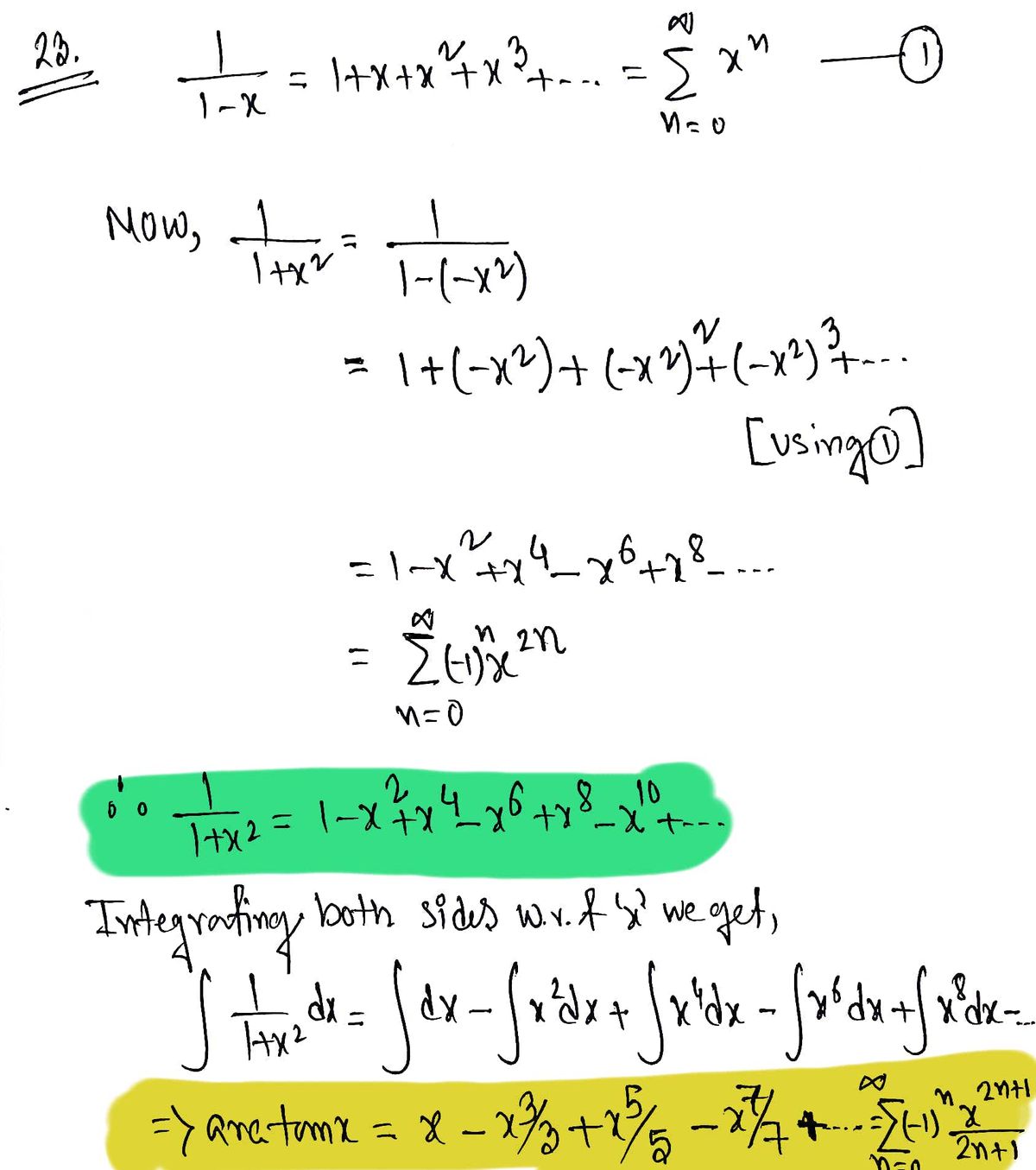Problem 23. Use the geometric series, = 1+x+r² + x³ + •. to obtain a series for and use this to obtain the series Eo ", %3D 1 1 E(-1)"; arctan a = r - -.. D 2n +1 0 Use the series above to obtain the series =Eo(-1)"z+1
Problem 23. Use the geometric series, = 1+x+r² + x³ + •. to obtain a series for and use this to obtain the series Eo ", %3D 1 1 E(-1)"; arctan a = r - -.. D 2n +1 0 Use the series above to obtain the series =Eo(-1)"z+1
Advanced Engineering Mathematics
10th Edition
ISBN:9780470458365
Author:Erwin Kreyszig
Publisher:Erwin Kreyszig
Chapter2: Second-order Linear Odes
Section: Chapter Questions
Problem 1RQ
Related questions
Question
100%
#23

Transcribed Image Text:2:21
( Safari
< RealAnalysis-ISBN-fix...
(b) Let s(x, N) = E-0 2 rn+1 and c(x, N) = En=o 2n r2n
and use a computer algebra system to plot these for -4n <a < 4n, N =
1, 2, 5, 10, 15. Describe what is happening to the series as N becomes
larger.
Problem 23. Use the geometric series, = 1+x+x²+x³ + • . .= E ",
to obtain a series for and use this to obtain the series
1
arctan x = x -
(-1)"
2n+1.
5*
2n +1*
n=0
Use the series above to obtain the series = E.(-1)"
The series for arctangent was known by James Gregory (1638-1675) and it is
sometimes referred to as "Gregory's series." Leibniz independently discovered
1 =1-+ - by examining the area of a circle. Though it gives us
a means for approximating a to any desired accuracy, the series converges too
slowly to be of any practical use. For example, if we compute the sum of the
first 1000 terms we get
/1000
4E(-1)";
2n + 1
2 3.142591654
n=0
which only approximates a to two decimal places.
Newton knew of these results and the general scheme of using series to
compute areas under curves. These results motivated Newton to provide a
series approximation for a as well, which, hopefully, would converge faster. We
will use modern terminology to streamline Newton's ideas. First notice that
1 = L-0 V1 - x² dx as this integral gives the area of one quarter of the unit
circle. The trick now is to find series that represents VI– a².
To this end we start with the binomial theorem
(a + b)N = £ (, )ax-",
where
N!
n! (N – n)!
N (N – 1) (N – 2).. · (N – n+1)
n!
II"-0 (N – j)
n!
Unfortunately, we now have a small problem with our notation which will
be a source of confusion later if we don't fix it. So we will pause to address this
matter. We will come back to the binomial expansion afterward.
Next
Dashboard
Calendar
To Do
Notifications
Inbox
Expert Solution
Step 1

Step by step
Solved in 2 steps with 2 images

Recommended textbooks for you

Advanced Engineering Mathematics
Advanced Math
ISBN:
9780470458365
Author:
Erwin Kreyszig
Publisher:
Wiley, John & Sons, Incorporated

Numerical Methods for Engineers
Advanced Math
ISBN:
9780073397924
Author:
Steven C. Chapra Dr., Raymond P. Canale
Publisher:
McGraw-Hill Education

Introductory Mathematics for Engineering Applicat…
Advanced Math
ISBN:
9781118141809
Author:
Nathan Klingbeil
Publisher:
WILEY

Advanced Engineering Mathematics
Advanced Math
ISBN:
9780470458365
Author:
Erwin Kreyszig
Publisher:
Wiley, John & Sons, Incorporated

Numerical Methods for Engineers
Advanced Math
ISBN:
9780073397924
Author:
Steven C. Chapra Dr., Raymond P. Canale
Publisher:
McGraw-Hill Education

Introductory Mathematics for Engineering Applicat…
Advanced Math
ISBN:
9781118141809
Author:
Nathan Klingbeil
Publisher:
WILEY

Mathematics For Machine Technology
Advanced Math
ISBN:
9781337798310
Author:
Peterson, John.
Publisher:
Cengage Learning,

